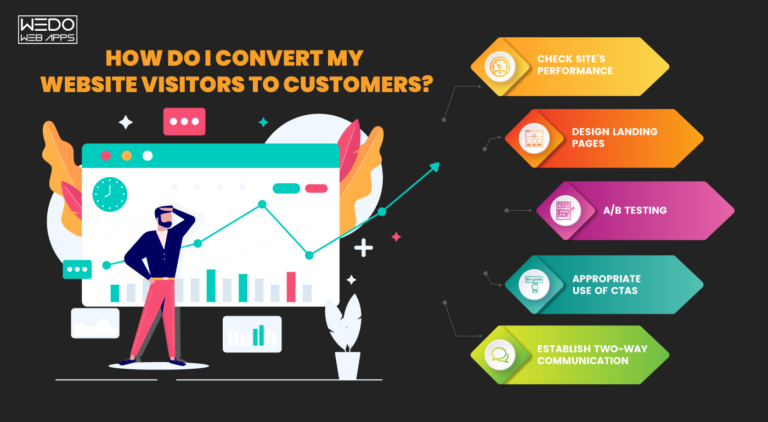28 Aug, 2022 | web page design
What Strategies Do Best Web Design Company Websites Use To Improve Their Conversion?

What is Conversion?
In layman’s terms, the conversion rate is the percentage of visitors coming to your website & completing the desired action. This desired action depends upon your end goal. It can be signing up for a subscription, filling out a form, downloading an ebook, or placing an order straightaway. The conversion ratio (conversion rate) is the percentage of the customers converting in proportion to the visitors on your website. You may not believe it, but the ideal conversion rate of the website is somewhere between 3% to 5% and that too after a lot of hard work & efforts you put. If you are a shop owner or serving the business industry irrespective of business niche, you surely know that every visitor coming to your store does not buy your offerings. Likewise, every visitor coming to your website is your potential customer, but they may or may not buy from you. In contrast to a physical store, you can’t talk to your customer’s to make them stay & convert, and that’s why you have to make your website do that. Now, that’s the tricky thing to make your website communicate like an individual. It’s the time to talk about the strategies that best web design company websites adapt to improve their rate of conversion.How do I convert my website visitors to customers?
Your website is the primary entity of your business. Keep your site updated and try below tactics to improve engagement with Check site’s performance: When talking about the performance metrics of your website, it involves analyzing the page load speed, responsiveness, media elements and their representation format, accessibility features for easy access on the web from multiple sources, and resolution of bugs from the backend. There can be requirements of scaling graphics or optimizing different sections of your website, you can check with Google Pagespeed Insights, GT Metrix to get information about the overall performance of your website. Design landing pages: You can have as many landing pages as you need. Depending upon the utility and end goal that you want to create, design the landing page for your website. The web page design of your landing page must have a catchy phrase in above the fold region, keyword-rich and precise content explained about your goal, relatable graphics and other media elements with a CTA button to let the user interact with the website. Leave enough oxygen space for your users by managing white space on the web page. Maintain consistency in design exactly like that of your website. A/B testing: There is no fixed design rule or idea that can be implemented on any site to make the customers stay. The conversion can be considered as the success of the website, and there is no formula to attain it. The secret is simply to keep trying and don’t stop even if you succeed, try working for more. A/B testing is keeping 2-3 variants of your landing pages. You will be tweaking the content or images every fortnight and check the response of customers upon the same. Appropriate use of CTAs: Call-to-action or CTA buttons are added on banners or other sections of your site to let people explore and not leave instantly. But, this doesn’t mean to fill your entire page with CTAs. The customer may get confused or click on secondary CTA, which may not be necessary as per your goal of conversion. Be picky about the colour and typography of CTA buttons; add basic animation when customers take action to hover or click. Want to boost your conversion rates? Our WordPress development agency employs effective strategies used by top web design companies to improve conversions. Establish two-way communication: You can’t succeed in making sales if you are the only one speaking about your offerings. When you are talking about your products and services, your customers will have the query, and by giving them options to talk to you about, you will be creating opportunities for conversion. You can integrate the live chat tools, add subscriptions forms and create a survey to get the customer feedback from time to time. Users can interact with you on live chat, but adding an FAQ page will be more effective, as common queries will be answered in prior.Tools to help you with conversion rate optimization
Your website has the potential to attract people, to convert them to customers and retain them for a lifetime. But, it’s not a one-time establishment, website optimization is the process. Any idea or marketing tactic that has worked for one time may or may not work forever. The result of these strategies can bring a long-term impact when you evaluate your website timely and curate your strategies based on your analysis. Majority of you have already been using Google Analytics to understand the analytics of user behaviour with your website. If you haven’t tried yet, configure your website with Google Analytics & Google Search Console to know your users better. Moreover, you can take help of CRM and analytics tools to help you with more data about your website. You can count on tools like Hubspot CRM, Lucky Orange, Hotjar, Crazy Egg, and many others. This third-party software will give more information about customer interaction at your website in the form of charts and heat maps that can help you update your strategies for conversion rate optimization. Learn the strategies web design companies use to improve conversion rates and apply them with our website development services UK. If you are looking for professionals to help you at the marketing front to improve the conversion rate of your website, you can reach us at sales@www.wedowebapps.co.uk.Frequently Asked Questions
Top web design companies use a variety of techniques to improve conversion rates, including optimizing website speed, ensuring responsive design for mobile users, using clear and concise language, creating easy-to-navigate layouts, highlighting key selling points, and implementing effective calls to action. They also conduct regular user testing and analyze data to identify areas for improvement and continually test and refine their approach. In addition, they strive to create a positive user experience that builds trust and encourages visitors to engage with the site and take action.
User experience and usability are crucial components of conversion optimization for businesses in the United Kingdom. By improving the user experience on your website, you are able to reduce bounce rates and increase the time spent on your site. This can result in higher engagement, improved brand loyalty, and ultimately, increased conversions. Usability plays a role in conversion optimization by making sure that your website is easy to navigate, and that users can easily find what they are looking for. This can significantly improve the overall user experience and lead to higher conversion rates.
Many companies in the UK use data and analytics to optimize their websites by tracking user behavior and demographics, such as how long people spend on their site, which pages they visit, and what items they purchase. They then use this data to make informed decisions about site design, layout, and content, and to create more effective marketing campaigns. For example, a company might discover that users are spending less time on their product pages than they are on their blog articles, and use this information to improve their product descriptions and images or to adjust the layout of the page. Additionally, analytics can help businesses track the outcomes of their marketing efforts, such as which ads are generating the most clicks or conversions. This information can be fed back into website design or marketing decisions, continually optimizing the site for better performance.
One successful case study of website conversion optimization in the UK is the work done by Conversion Rate Experts on the website for SEOmoz. They were able to increase the website's revenue by 52% through a series of changes, including the simplification of the website's navigation and the optimization of the checkout process. Another successful case study is from Creative Stream, who worked with hotel chain Travelodge to optimize their website by conducting user testing and implementing changes based on the results. This led to a 22% increase in bookings through the website. Finally, VWO worked with Scottish charity Mary's Meals to optimize their website's donation process, leading to a 64% increase in donations.
User experience (UX) can have a significant impact on website conversions. A website’s design, functionality, and content all play a vital role in creating a positive or negative user experience. Poor UX can lead to high bounce rates or abandoned shopping carts, while a positive UX can lead to increased engagement and conversions. Some ways to improve UX and ultimately increase conversions include creating an intuitive layout, using clear and concise language, optimizing page loading speed, providing easy navigation, and addressing user pain points. It's also important to regularly conduct user tests and gather feedback to continuously improve the website's UX.

